 Sintra, Portugal
Sintra, Portugal
by Ana Astri-O’Reilly
From the train I can see one seemingly small turret on top of a hill. And then another. Then I see that they are joined by a wall. The effect is that of a saddle. They are so high up that it makes me wonder how I will ever reach the castle. The train comes to a halt at Sintra, the end of the line. I look up: the turrets don’t look any closer. Maybe taking the bus is a good option.
 Once I pay for my ticket at the ticket office housed in a trailer, I follow the signs and go through the turnstile. I walk past some workers manning a zip line that allows them to bring up wood planks and other constructions materials from down below for restoration work at the castle. I follow the signs along the path.
Once I pay for my ticket at the ticket office housed in a trailer, I follow the signs and go through the turnstile. I walk past some workers manning a zip line that allows them to bring up wood planks and other constructions materials from down below for restoration work at the castle. I follow the signs along the path.
I walk past the chapel and a memorial, the medieval tombs, the big stone silos and the water cisterns on my way towards the battlements. I’m amused by the Traitors’ Gate, an impossibly small entrance. I wonder how it got its name.
O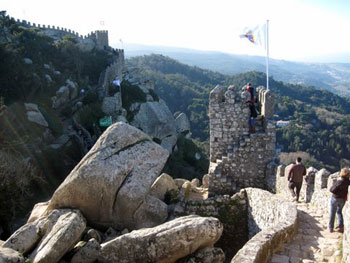 nce I reach the battlements, I can see undulating land disappearing in the distance beyond the stone walls. The Portuguese flag and the Moorish banner flutter in the cool winter breeze. It felt damp and cold in the shade but warm –too warm to wear a jacket- out in the sun. The turrets and keep glowed in the afternoon light, in sharp contrast with the darkness created by the dense vegetation below.
nce I reach the battlements, I can see undulating land disappearing in the distance beyond the stone walls. The Portuguese flag and the Moorish banner flutter in the cool winter breeze. It felt damp and cold in the shade but warm –too warm to wear a jacket- out in the sun. The turrets and keep glowed in the afternoon light, in sharp contrast with the darkness created by the dense vegetation below.
The battlements are narrow and low and the stone steps, worn. There are no railings either. It is quite an adventure to go from one turret to another. If somebody is coming in the opposite direction, one of you will have to flatten against the wall to give way to the other.
 The Moorish invaders began to build what is now known as the Moorish Castle (Castelo dos Mouros) in the 8th century. Its vantage point at the top of the hill is a perfect defensive position. It’s easy to imagine the sentries marching along the walls, keeping an eye out for the Christian armies. And it is equally easy to picture the hosts of King Afonso VI swarming up the hills in 1093 in a successful attempt to take Sintra from the Moors. The fortress changed hands between Moors and Christians a few times more until Lisbon was conquered by Dom Afonso Henriques (the first king of Portugal) in 1147, when the Moors surrendered the castle to him.
The Moorish invaders began to build what is now known as the Moorish Castle (Castelo dos Mouros) in the 8th century. Its vantage point at the top of the hill is a perfect defensive position. It’s easy to imagine the sentries marching along the walls, keeping an eye out for the Christian armies. And it is equally easy to picture the hosts of King Afonso VI swarming up the hills in 1093 in a successful attempt to take Sintra from the Moors. The fortress changed hands between Moors and Christians a few times more until Lisbon was conquered by Dom Afonso Henriques (the first king of Portugal) in 1147, when the Moors surrendered the castle to him.
The Moors were able to withstand siege with fresh water from the springs, which they channeled into the cisterns, with the grain that they stored in the silos and because the castle was impregnable. However, it was impregnable on only three sides. Its Achilles heel is the sloping woods. It’s not difficult to see how Dom Afonso was able to override their defenses and storm the fortress. The chapel of S. Pedro de Canaferrim was added to the castle after the conquest as the parish seat.
The castle, as so much in Portugal, is an intriguing mix of Christian and Moor.
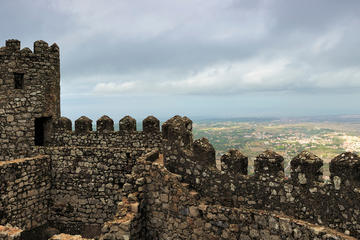
Private Sintra Tour from Lisbon with Wine Tasting and Moorish Castle
If You Go:
Getting there:
♦ Sintra is located about 20 miles northwest of Lisbon.
♦ Rossio Station (Linha de Sintra) 39 minute ride. Trains depart every 15 minutes, and at the time of writing the fare was €2.05 each way.
♦ At Sintra Station take the number 434 bus -run by Scotturb- to Castelo dos Mouros. It runs in a loop called Circuito da Pena. It goes up and down the hill stopping at each attraction. A return ticket was €5.00 at the time of writing. The castle can be reached on foot from Sintra but the lack of sidewalks and too many bends make it somewhat treacherous. The bus is a safer and faster option.
Sources:
Parques de Sintra www.parquesdesintra.pt
Comboios de Portugal – Linha de Sintra www.cp.pt
About the author:
Ana Astri-O’Reilly is originally from Argentina and now lives in Texas. She worked as a translator and foreign language instructor in her native Buenos Aires. Now she is a contributing editor at PocketCultures.com and writes about travel on the blog Ana Travels (anatravels.com). She speaks fluent Spanish, English and some Portuguese.
Facebook: www.facebook.com/anatravels
Twitter: twitter.com/anaoreilly
Travel blog (English) anatravels.org
Food blog (English) foodtrailsandtales.wordpress.com
Blog personal (castellano) apuntesideasimagenes.wordpress.com/
Photo credits:
All photos are by Ana Astri-O’Reilly.
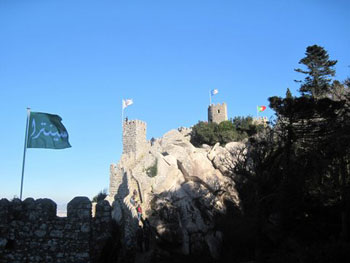 Sintra, Portugal
Sintra, Portugal
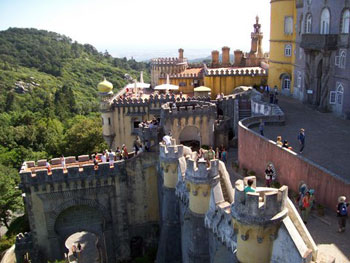
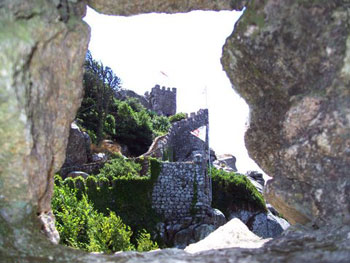 Looking south standing under a mountain-top cross surrounded by lush vegetation in Sintra’s Romantic-period Pena Palace park I wondered if the human construction in the distance was Lisbon. Then I saw a red bridge glinting in the sun, confirming it was Portugal’s capital city twenty-five miles away on the Tagus estuary. It could have been the Golden Gate bridge signalling San Francisco, but I was a long way from California; and the previous day I’d passed the 25 April bridge and a Rio-style Christ statue on the way to Belem, where Portuguese sailors departed on their most famous voyages of discovery.
Looking south standing under a mountain-top cross surrounded by lush vegetation in Sintra’s Romantic-period Pena Palace park I wondered if the human construction in the distance was Lisbon. Then I saw a red bridge glinting in the sun, confirming it was Portugal’s capital city twenty-five miles away on the Tagus estuary. It could have been the Golden Gate bridge signalling San Francisco, but I was a long way from California; and the previous day I’d passed the 25 April bridge and a Rio-style Christ statue on the way to Belem, where Portuguese sailors departed on their most famous voyages of discovery. A half-fish, half-man statue; an allegory for the creation of the world; greets visitors to the central courtyard of the Pena Palace. Entering the Manueline Cloister to view the living quarters, the sun was almost directly above a tall green plant rising out of a grey turtle-stoned pot in the centre of the unroofed inner courtyard. Upstairs, we could walk past the open bedrooms, which were surprisingly small; and through the communal rooms, which were as stylish as expected. Other highlights of the palace included the small ancient chapel, the Great Royal Hall and the kitchen; the latter now houses a cafe, with an outside terrace.
A half-fish, half-man statue; an allegory for the creation of the world; greets visitors to the central courtyard of the Pena Palace. Entering the Manueline Cloister to view the living quarters, the sun was almost directly above a tall green plant rising out of a grey turtle-stoned pot in the centre of the unroofed inner courtyard. Upstairs, we could walk past the open bedrooms, which were surprisingly small; and through the communal rooms, which were as stylish as expected. Other highlights of the palace included the small ancient chapel, the Great Royal Hall and the kitchen; the latter now houses a cafe, with an outside terrace.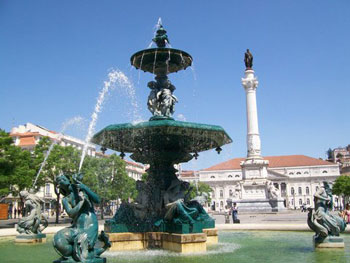 On the way up to the palace I had visited the Moorish Castle. It is now mostly just a long wall with towers above foundations being archaeologically excavated, but it still inspires the imagination, and provides the best views on the mountain of Sintra and the northern plain. The castle was built in the eighth and ninth centuries during the Moors’ occupation of the region, before Portuguese forces regained control in the eleventh century. You can buy tickets for both the castle and Pena Palace at the castle entrance. The castle provides a good break if walking from Sintra to the palace. There are also regular buses.
On the way up to the palace I had visited the Moorish Castle. It is now mostly just a long wall with towers above foundations being archaeologically excavated, but it still inspires the imagination, and provides the best views on the mountain of Sintra and the northern plain. The castle was built in the eighth and ninth centuries during the Moors’ occupation of the region, before Portuguese forces regained control in the eleventh century. You can buy tickets for both the castle and Pena Palace at the castle entrance. The castle provides a good break if walking from Sintra to the palace. There are also regular buses. Lisbon’s train station for Sintra is the Rossio, which is conveniently also the city’s most central. Sintra was the only time I used the train service in Lisbon, as I travelled between Lisbon and the south coast by bus; the Eva service was comfortable and punctual, but there were no toilets or rest-stops on the three-hour journey.
Lisbon’s train station for Sintra is the Rossio, which is conveniently also the city’s most central. Sintra was the only time I used the train service in Lisbon, as I travelled between Lisbon and the south coast by bus; the Eva service was comfortable and punctual, but there were no toilets or rest-stops on the three-hour journey.
 The Chiado is a popular area of Lisbon, between the city centre; Baixa; and the Bairro Alto district. The latter’s narrow cobbled streets and balconied houses ooze age and character. Everything is in easy walking distance, with the Baixa’s plazas interconnected by picturesque streets, squares and statues. The area was rebuilt after a big earthquake in 1755. Restaurants with smartly dressed waiters and waitresses frame the plazas, continue up the eastern hill towards St. George’s Castle, and down to the Tagus a few blocks to the south.
The Chiado is a popular area of Lisbon, between the city centre; Baixa; and the Bairro Alto district. The latter’s narrow cobbled streets and balconied houses ooze age and character. Everything is in easy walking distance, with the Baixa’s plazas interconnected by picturesque streets, squares and statues. The area was rebuilt after a big earthquake in 1755. Restaurants with smartly dressed waiters and waitresses frame the plazas, continue up the eastern hill towards St. George’s Castle, and down to the Tagus a few blocks to the south.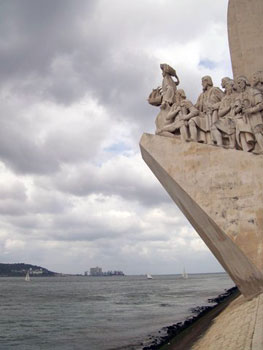 Maybe the sailors sometimes imagine they are Henry the Navigator or Vasco da Gama as they sail out to sea. Henry was a 15th century royal who is credited with being instrumental in developing Portugal’s most rewarding era of exploration and trade. His statue looks out over the Tagus at the head of the impressive Monument to the Discoveries. Behind him are thirty-two notable figures from that era, with sixteen on each side of the caravel-shaped structure; the caravel boat revolutionised Portuguese sailing after being designed with sponsorship from Henry.
Maybe the sailors sometimes imagine they are Henry the Navigator or Vasco da Gama as they sail out to sea. Henry was a 15th century royal who is credited with being instrumental in developing Portugal’s most rewarding era of exploration and trade. His statue looks out over the Tagus at the head of the impressive Monument to the Discoveries. Behind him are thirty-two notable figures from that era, with sixteen on each side of the caravel-shaped structure; the caravel boat revolutionised Portuguese sailing after being designed with sponsorship from Henry.
